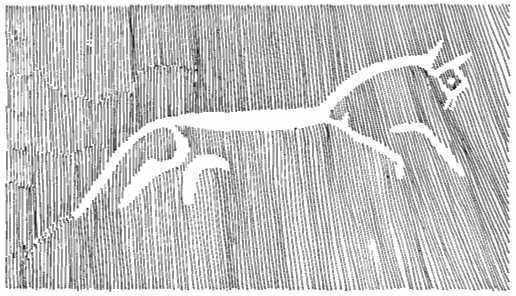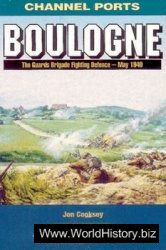There are about fourteen white horses in Wessex, of which only one has a genuine claim to antiquity. This is the White Horse of Uffington, which was carved high up on the chalk escarpment, immediately below the Iron Age hillfort of Uffington Castle (figure 6.21). The interesting point about the drawing of this horse is that it was not a simple graffito cut into natural chalk. Instead, a trench was deliberately dug into the lynchet (a deep accumulation of plough wash at the edge of a field) and this was filled

Figure 6.21 The White Horse at Uffington, first century BC, Uffington, Oxfordshire. Paul Jenkins.
With chalk. The image was therefore cut into an artificial trench especially prepared for it: the whole animal appears entirely in chalk rather than as an outline cut into turf, a startlingly clear sight from a long distance.
At present, the horse is abstract in design with a long, thin, sinuous body, disjointed legs and a bird-like, beaked face. Its style alone has led to its interpretation as a Celtic image belonging, perhaps, to the local tribe of the Atrebates. Similar treatment of horse images can be seen on Celtic coins and on a bronze Iron Age horse-model found at Silchester, the tribal capital of the Atrebates. But the present horse at Uffington is by no means identical to its original. It has to be remembered that it has undergone as much as 2,000 years (if it is indeed Celtic) of silting, erosion and scourings or cleanings. There is the danger, too, that it has been restored as a deliberate archaism: the 'beak', for instance, resembles Celtic images of horse-heads and there was a medieval tradition of depicting beaked animals: this occurs, for example, on a thirteenth-century jug in the British Museum.
If we envisage the Uffington White Horse as a landmark, it has to be appreciated that silting has caused the figure to tilt away from the viewer who is observing the horse from below. It was originally on much more of a slope and its body was thicker. The animal was subsequently much more of a landmark, more easily visible when it was originally carved than today. Indeed, the horse has seemingly 'crept up the hill'; this has given rise to a local legend that the horse has climbed the hill on his own. This weathering effect was appreciated in the eighteenth century: Francis Wise in 1738 wrote in a letter that the rains
Occasion the turf on the upper verge of his body. . . to crumble, and fall off into the white trench. . . which is the reason why the country people erroneously imagine that the horse. . . has shifted his quarters and is got higher upon the hill than formerly.
The Uffington White Horse has a long historical pedigree: the first accounts date back to the eleventh and twelfth centuries. White Horse Hill is mentioned in 1084, and there is another early reference in 1190. Thus the horse must have been a well-known landmark well before 1200. The earliest certain picture of the White Horse is on a Sheldon Tapestry map dating to the late sixteenth century in the Victoria and Albert Museum.
Numerous scourings of the White Horse have been recorded, from about 1650 to 1900. Traditionally, scourings took place every seven years. In the seventeenth century, Thomas Baskerville alluded to the obligation on local inhabitants 'to repair and cleanse this landmark, or else in time it may turn green like the rest of the hill, and be forgotten'. He also suggested that the people working on the horse should enlarge the belly as it was too slender when seen from a long way off. In 1720, Thomas Cox wrote about the people around midsummer going to weed the horse to keep it in shape and colour. After the work was completed, there were feasting and jollification, ceremonials and festivals. Twenty years later, Francis Wise expressed his regret that the scouring had been left to the common people, who were not bothering to do it properly. There was an angry retort to this allegation by one William Asplin, who wrote a pamphlet called 'The Impertinence and Imposture of Modern Antiquaries Displayed'. In it, Asplin stated that the scourers were energetic enough with the mattocks and spades but were somewhat hurried to get their reward, 'a bellyful of ale'. Another comment some thirty years later in 1770 says that after the midsummer scouring, the people went off to different public houses to spend the evening in 'all sorts of rural diversions'. The scourings and associated festivities continued until after the Industrial Revolution and the introduction of the railways. Thomas Hughes, author of Tom Brown's Schooldays, wrote a treatise entitled 'The Scouring of the White Horse', which was a graphic description of the last great scouring in 1857.
Various festivals and legends surround the White Horse. We know of a late fertility festival of cheese-rolling down the steep slope where the horse is carved, into the field below. A tradition is that the White Horse was Saint George's mount: there is, of course, Dragon Hill nearby. Francis Wise records this in the eighteenth century. A supremely bad verse written by a shepherd on White Horse Hill in the early nineteenth century is worth recording:
If it is true as I heard say
King George did here the Dragon slay,
And down below on yonder hill They buried him, as I heard tell.
But the strongest view is that the original Uffington White Horse was carved perhaps around 50 BC as the tribal emblem of the Atrebates and associated with the Iron Age hillfort of Uffington Castle on the hill above. There is evidence of Roman activity in the slighted (i. e. destroyed by enemy action) hillfort ditches, which may possibly have some religious significance. The question has to be asked whether the early date suggested for the carving can be substantiated on stylistic grounds alone. Recent work by the Oxford Archaeological Unit has thrown some valuable new light on the horse itself and its surroundings. First, the area is under pasture - rare in this region - and it is now known that it was under grass in antiquity too. This could be significant: the inference is that the area was perhaps deliberately kept clear of arable usage from very early and that the horse may also have thus been carved early. Research is also being carried out on the construction of the image itself, partly to try and establish a chronological sequence, partly to attempt to substantiate or disprove that its present style was the original design. What has been discovered is that the horse is, in fact, a kind of equine layer-cake; at least four layers of chalk-filled trenches have been found. The horse was extensively restored after the Second World War and at this time, a trench adjacent to the 'beak' of the horse was excavated. The results showed two successive phases of beak, separated by hillwash and positioned some way above the chalk bedrock. The Oxford Unit has now reopened this trench and has revealed not two but four successive beaks, the earlier beaks larger than the present one. More investigations around and below the belly of the horse have proved that it was once thicker but that it always possessed this highly stylized shape. There is no evidence that it was once more naturalistic in form.
These new investigations have already demonstrated that the schematism in the design of the Uffington image is genuine, implying a Celtic origin for the horse. It has partially laid to rest controversy concerning the chronology in that, if the horse had been a more naturalistic, horse-like creature when it was first carved, then this would argue for a later date, perhaps within the Saxon period. A new optical dating technique developed by the Oxford Research Laboratory is currently being employed to try and date the silt deposits interstratified with the horse carvings. Preliminary results endorse the view that the horse is an authentic carving of the pagan Celtic period.
If it is Celtic, then the Uffington White Horse could be one of Britain's earliest pieces of monumental evidence for horse symbolism.78




 World History
World History









